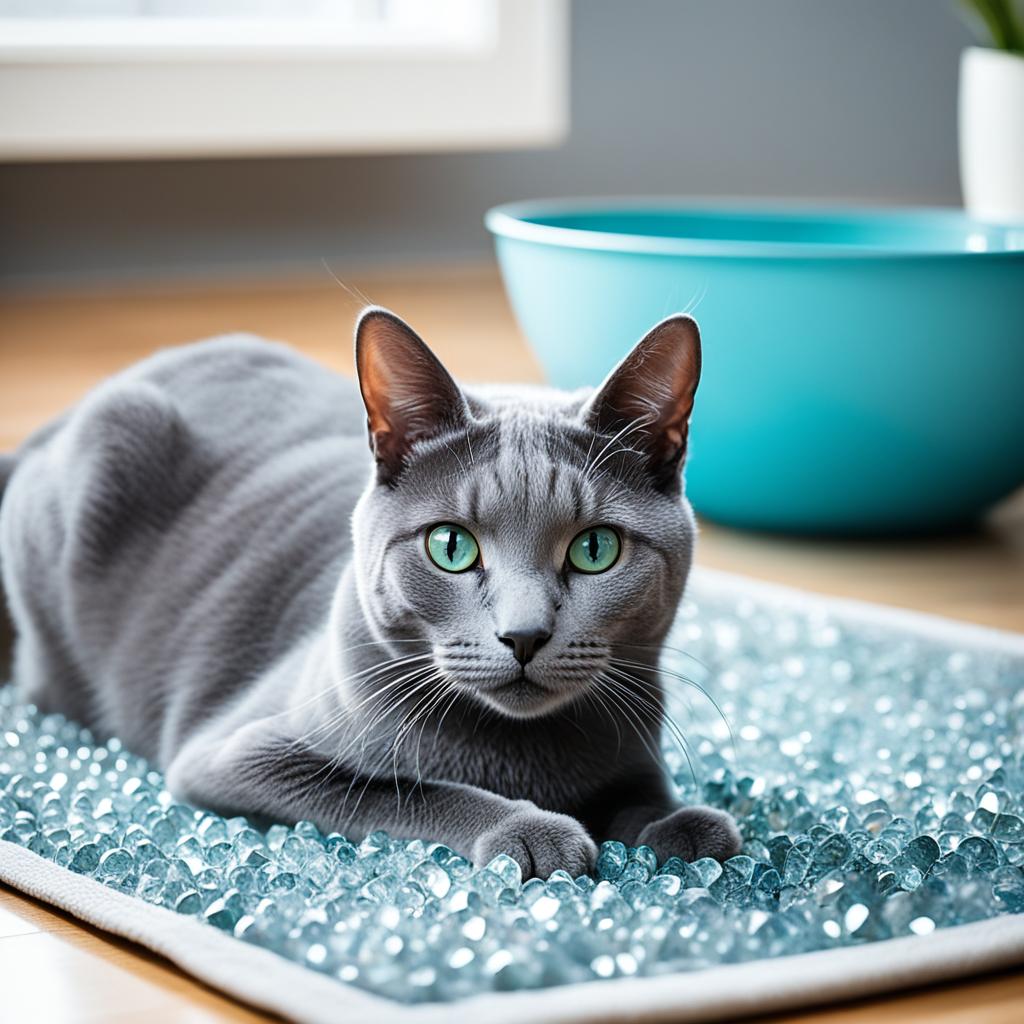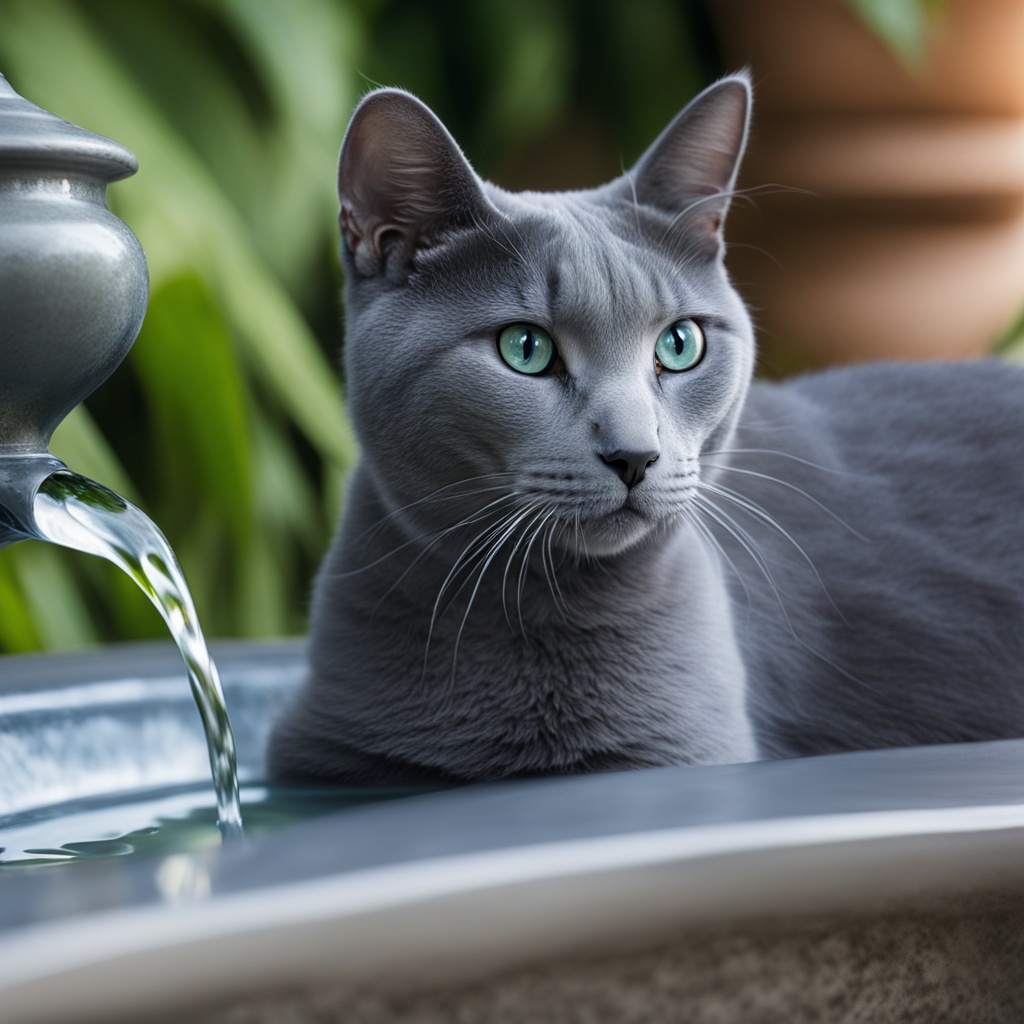Is your Russian Blue cat not able to use the litter box properly? You’re not the only one facing this challenge. The big question is, why is this happening? It’s important to tackle this issue since it can affect your cat’s overall health. To keep your furry friend happy and well, it’s vital to address their urinary problems.
To be a good pet owner, you must know the risks and spot early signs. This means learning about treatment options and caring for your cat’s health. We’re going to focus on your special Russian Blue’s urinary health in this article.
Key Takeaways
- Urinary issues in Russian Blue cats require immediate attention to prevent severe health complications.
- Recognizing early symptoms such as frequent litter box visits and behavioral changes is crucial.
- Prevention involves maintaining proper hydration, appropriate diet, and reducing stress.
- Understanding the specific needs and predispositions of Russian Blue cats can aid in better management.
- Early veterinary intervention and ongoing home care are critical for your cat’s urinary health.
Understanding Urinary Blockages in Russian Blue Cats

Dealing with urinary problems in a Russian Blue cat can be tough. But, if you know the signs and causes, you can manage these issues better. Urinary blockages are a big worry for cat health, mainly in male cats. Learning about them can keep your cat healthy and happy.
Signs and Symptoms
Spotting the signs of urinary issues early is key for better outcomes. Watch for more trips to the litter box but less urination, painful cries, and too much cleaning of the private area. With these signs, it’s time for a vet visit to avoid toxin build-up.
Causes of Blockages
Urinary blockages often come from mucus plugs with crystals and mucus. Male cats are at more risk because of their longer urethras. Things like bladder stones, diet, and stress can also lead to blockages. Knowing these causes helps prevent issues.
It’s vital to get your cat to the vet fast for blockages. Quick treatment can avoid major health problems and keep your Russian Blue healthy.
Genetic Factors Influencing Urinary Health

Your Russian Blue Cat’s DNA offers big hints about their urinary health. Learning about these genes help in caring for your pet’s well-being. So, let’s dive into the details!
Breed Specific Traits
Russian Blue cats have unique coats and eyes. But, they are also more likely to have urinary health problems. Spotting these issues early can help in better care for their urinary health.
Common Genetic Conditions
They might inherit health issues like kidney disease or crystals in the urine. These issues are complex but knowing about them is key. By watching for symptoms and regular vet visits, you can help your cat live a better life.
Importance of Hydration

Keeping your cat hydrated is key for their cat health. Not drinking enough water can lead to urinary issues. It’s important because water helps remove harmful substances from their body.
Proper Water Intake
Cats don’t drink much because they’re pure meat eaters. So, watching how much water they take in is crucial. Make sure they always have fresh water. Also, know how much your cat usually drinks. Adding a bit of tuna juice can make water more appealing too.
Encouraging Your Cat to Drink More Water
Making your cat want to drink more can be fun. Water fountains that move can catch their eye. Wet food is also a good choice because it has more water in it. You should also have water bowls in different parts of the house. This makes it easy for your cat to get a drink any time.
- Introduce a pet water fountain
- Mix wet food with their diet
- Place multiple water bowls
- Add a splash of flavor to the water
Focusing on hydration really helps with your cat’s health. Using these ideas will help prevent urinary problems.
Diet Adjustments for Better Urinary Health

Ensuring your cat eats well is key for their urinary health. The diet plays a big part in keeping urinary problems at bay. With the right food, your cat can enjoy a healthier and more active life.
Role of Diet in Preventing Urinary Issues
Foods affect your cat’s urinary system more than you think. Too much magnesium, ammonium, and phosphate can cause crystals. It’s crucial to keep these minerals in check. Plus, some cat foods help keep the urine just right to stop crystal growth.
Commercial Cat Foods vs. Homemade Diets
Picking between store-bought and homemade food has its challenges. Special cat foods can be great at preventing issues because they’re carefully designed. Yet, making food at home means you can pick every ingredient. This is good but needs you to know a lot about what cats need.
| Feature | Commercial Cat Foods | Homemade Diets |
|---|---|---|
| Convenience | Easily Accessible and Time-Saving | Requires Preparation Time and Effort |
| Nutrient Balance | Formulated for Balanced Nutrition | Requires Understanding of Feline Nutritional Needs |
| Prevention Techniques | Specialized Formulas for Urinary Health | Customizable but Needs Careful Management |
Understanding Urine pH Levels
It’s key to understand Urine pH Levels for your Russian Blue cat’s health. The pH level in your cat’s urine helps you pick the right foods for their urinary health. It’s an important guide.
Ideal pH Range
Your cat’s urine should be a bit acidic, aiming for 6.3 to 6.6. This keeps their system balanced and stops crystals from forming. Health issues like urinary blockages can pop up if the pH strays. This is especially true for Russian Blue cats.
Impact of Diet on pH
What your cat eats really impacts their urine’s pH. Some cat foods can make the urine too alkaline, upping the risk of crystals. Other diets can make the urine too acidic, which is bad for different types of stones. Tweaking your cat’s diet is crucial to keeping their urine pH levels right.
| Diet Type | Effect on Urine pH | Risk |
|---|---|---|
| Commercial Diet High in Magnesium | Increases Alkalinity | Struvite Crystal Formation |
| Prescription Diet for Urinary Health | Balances pH Levels | Prevents Both Crystal Types |
| Diets High in Animal Protein | Increases Acidity | Risk of Calcium Oxalate Stones |
Watching and knowing your cat’s urine pH levels is vital. It helps you adjust their diet to manage their urinary health better.
How to Address Russian Blue Cat Urinary Issues?

If your Russian Blue cat shows signs of trouble urinating, quick action is key. Acting early can avoid bigger problems and help your cat get well fast. You need to take both immediate and long-term steps to help.
Immediate Steps to Take
First, watch for signs of distress like going to the litter box often but not peeing much, crying in pain, or acting uncomfortable. Then, do the following without delay:
- Call your vet right away
- Make your cat comfortable and keep everything quiet
- Make sure your cat drinks water while waiting for the vet’s advice
Long-term Management Strategies
For ongoing health, managing your Russian Blue cat’s urinary issues is crucial. Here are steps to take to keep your cat doing well over time:
- Change their diet to one that’s good for their urinary system. This usually means avoiding certain foods and sticking to what the vet recommends.
- Get them to drink more water by using fountains and giving them wet food. This keeps their system flushed out.
- Keep your home peaceful and steady to lower stress levels. You might need diffusers or changes in your home’s setup to help with this.
- Always check in with the vet to make sure things are going well. They can do tests to keep an eye on your cat’s health.
Managing your Russian Blue cat’s urinary problems takes careful, ongoing effort. Being alert and proactive can keep your cat’s system healthy.
| Strategies | Benefits | Examples |
|---|---|---|
| Diet Adjustments | Promotes urinary health by maintaining appropriate pH balance | Prescription diets, avoiding high magnesium foods |
| Increasing Water Intake | Prevents urine concentration and reduces blockage risk | Water fountains, wet food |
| Minimizing Stress | Reduces stress-induced urinary problems | Stable environment, pheromone diffusers |
| Regular Monitoring | Early detection of urinary issues | Routine vet visits, regular urine tests |
Recognizing and Preventing Urinary Tract Infections (UTIs)

Knowing about Cat Urinary Tract Infections is key for any cat owner. These infections can hurt your cat and make them very unhappy. Recognizing the signs early and using good prevention methods can keep your cat healthy and happy.
Symptoms of UTIs
Look out for these signs of Cat UTIs:
- Frequent attempts to urinate
- Blood in the urine
- Painful urination
- Inappropriate urination outside the litter box
- Lethargy and decreased appetite
Spotting these symptoms fast is important for the treatment and stopping any complications.
Prevention Techniques
It’s not hard to stop Cat UTIs from happening. Just follow these important steps:
- Keep the litter box clean: This lowers the chance of bacterial infections.
- Give plenty of fresh water: Water keeps cats healthy. Be sure to provide clean, fresh water all the time.
- Watch their diet: Feed them a good diet to keep their urinary tract in good shape. Avoid foods high in magnesium.
- Take them for check-ups: Regular vet visits catch and treat any problems early.
- Less stress: Try to keep your cat’s living area calm. Stress can lead to UTIs.
Pro Tip: A water fountain can make your cat drink more water, which is good for their urinary health.
Role of Stress in Urinary Problems

Stress can quietly lead to urinary issues in cats. It’s key to understand how stress affects your cat. By managing stress effectively, you can help prevent urinary problems.
How Stress Affects Your Cat
Stress is not just for humans; cats feel it too. It greatly affects their health. High stress can lead to bad behaviors that worsen urinary problems.
These behaviors include over-grooming and changes in eating and urination. When a cat is stressed, it releases hormones. These hormones can cause bladder inflammation. So, it’s important to quickly deal with anything that stresses your cat.
Stress Management Tips
Reducing stress in cats means creating a relaxing home. Here are some tips to keep your cat calm and safe from urinary issues:
- Establish a consistent daily routine to make your cat feel safe and secure.
- Avoid loud noises and swift movements that might upset your cat.
- Offer various toys and structures to keep your cat entertained and active.
- Make sure your cat has a quiet and safe place to escape to when they’re feeling stressed.
- Use pheromone products to help calm your cat.
- If needed, talk to your vet about anti-anxiety drugs made for cats.
By reducing stress, you’re helping your cat’s health and well-being. This is a key step in preventing urinary problems in cats.
Home Care Tips for a Healthy Urinary Tract

Keeping the litter box clean is key to keeping your cat’s bladder healthy. Follow these litter box hygiene tips. They help stop urinary problems and make your Russian Blue content.
Litter Box Hygiene
Cleaning the litter box daily is the first step. Always scoop out the waste. Change the litter completely once a week. This keeps bacteria low and helps your cat feel comfortable peeing there.
Regular Health Monitoring
Watch your cat closely for any unusual bathroom habits. If they show signs of struggling or go very often, there might be an issue. Seeing a vet regularly and monitoring their urine can catch any problems early.
Just by doing these simple things, you can promote your cat’s health. This makes for a happier cat and a happier home.
Veterinary Treatments and Interventions

Cat urinary issues can quickly go from small concerns to big problems. Knowing when to see a vet is crucial. Veterinary treatments are key to keeping your cat healthy.
When to Consult a Vet
If your cat is acting differently in the litter box, it could be a sign of trouble. Signs like urinating a lot, seeing blood in their pee, or struggling to go, are big warnings. It’s important not to ignore these warning signs.
Taking them for regular check-ups can help catch problems early. This could prevent them from getting worse and keep your cat healthy for a long time.
Common Veterinary Procedures
Vets have lots of ways to help with cat urinary issues. They might need to use a catheter to help with a blockage. Medications fight infections. Sometimes, surgery is needed to remove something blocking the urine flow.
Also, vets often suggest special diets to keep your cat’s urine healthy. Plus, they recommend keeping up with regular check-ups to make sure everything is going well. Remember, your cat’s health is worth the best care.
Case Study: Beaker’s Urinary Blockage Experience
Beaker is a beautiful Russian Blue cat with an important story to tell. It highlights how quick action can save a cat’s life. One day, his owner saw him going to the litter box often but doing very little.
His owner immediately took him to the vet when she saw this. There, the vet found a urinary blockage. Beaker needed a catheter to remove the blockage. He also started a special diet made for cat urinary tract health.
But the road to recovery was long. Beaker had to visit the vet multiple times. His diet had to be changed, and he needed to drink lots of water to stay healthy. Managing Russian Blue cat urinary issues is about more than just medicine. It’s also about the right food, enough water, and a calm home.
His owner watched over him carefully. She made sure he always had enough fresh water. And his home was always quiet and relaxed. This special care played a big part in Beaker’s recovery. Now, Beaker is happy and careful about his health. He shows how good care leads to excellent cat urinary tract health.
| Key Lessons from Beaker’s Experience | Tips for Owners |
|---|---|
| Early Detection Is Crucial | Monitor for signs of distress and act swiftly. |
| Holistic Care Approach | Implement a balanced diet and hydration regime. |
| Veterinary Support | Maintain regular vet check-ups and follow-ups. |
| Stress Management | Create a calm and stable environment for your cat. |
Conclusion
Dealing with urinary problems in your Russian Blue cat can be tough, but with knowledge, you can handle it better. It’s important to keep an eye on their health and know the signs early. Understanding the causes, like genetics and the need for good hydration and diet, is key.
If your cat shows any symptoms, getting them to the vet right away is crucial. But, it’s just as vital to keep up with their care at home. This helps keep their urinary tract and health in good shape. Stress management, clean litter boxes, and the right food are important steps toward a happy, healthy cat.
Caring for your Russian Blue with love, knowledge, and understanding is the best approach. By following the advice given, you can help your cat stay healthy. Creating a caring home environment is critical. It prevents urinary problems and helps your pet live a joyful, stress-free life.




